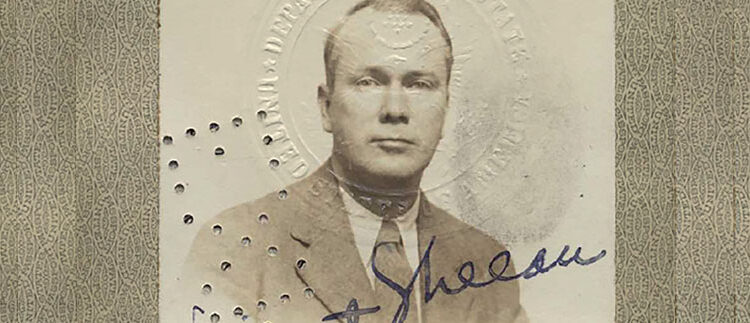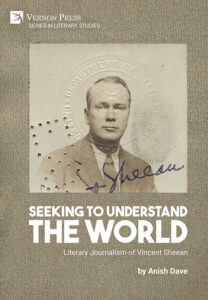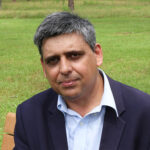
New Book: “Seeking to Understand the World: Literary Journalism of Vincent Sheean” by Anish Dave
Vincent Sheean was a paradigmatic American foreign correspondent in 1930s and 1940s. He won the inaugural National Book Award for biography for his 1935 book Personal History. The book became a model for many other contemporary foreign correspondents who wrote their own personal accounts of their journalistic experiences. When Sheean died in 1975, the New York Times published an obituary titled “Mentor of a Generation of News Reporters” (March 17, 1975). Paul L. Montgomery, the writer of the piece, remarked, “Sheean’s effort was best fulfilled in his books, to which he devoted most of his career after 1925.” Montgomery mentioned that Sheean “wrote 20 works of nonfiction.”
Literary journalism scholars have taken little note of Sheean, however, the only exceptions being a 1996 anthology by Edd Applegate (Literary Journalism: A Biographical Dictionary of Writers and Editors) and brief references in Ronald Weber’s 1980 book The Literature of Fact: Literary Nonfiction in American Writing and Michael J. Arlen’s 1972 article in the Atlantic, “Notes on the New Journalism.” More recently, journalism professor John Maxwell Hamilton has published a book chapter (in Second Read: Writers Look Back at Classic Works of Reportage) on Sheean’s Personal History and a biographical essay on Sheean in a 2009 book Journalism’s Roving Eye: A History of American Foreign Reporting. Additionally, history scholars Nancy Cott and Deborah Cohen have recently written books that include detailed narratives on Sheean’s life.
My monograph, Seeking to Understand the World: Literary Journalism of Vincent Sheean (2023, Vernon Press) is the first book-length study to offer literary analyses of Sheean’s books. It examines five of Sheean’s major nonfiction, journalistic books to highlight qualities of literary journalism that characterized his writing. Calling Sheean a literary journalist, I write that “the evidence for this claim is the books’ stories and scenes, well-crafted structures and sentences, imagery and symbolism, and lifelike characters and vivid descriptions” (p. 103). Sheean’s immersion in his settings, his empathy toward his subjects, “and his interactions with individuals and leaders from different cultures” are other reasons why describing him as a literary journalist is justified.
The book includes seven chapters, with a chapter on each of the five nonfiction, journalistic books. The introductory chapter provides a concise review of literary journalism scholarship, briefly analyzes two exemplary works of literary journalism by American foreign reporters John Reed (Ten Days That Shook the World) and John Hersey (Hiroshima), provides a biographical sketch of Vincent Sheean, and outlines the next chapters.
Chapter two analyzes Vincent Sheean’s celebrated Personal History, arguing that the book achieves its “novelistic character . . . due to the skillful cohesion of its varied narratives.” The elements contributing to the cohesion include “a linear, chronological structure”; “simple and short chapter titles”; “frequency of stories”; “crisp, informative sentences”; and “a distinctive narrator’s presence” (p. 33).
Chapter three examines Sheean’s 1939 book Not Peace but a Sword, concluding that the book’s “case for literary journalism rests on a much-praised story and a few lifelike scenes, the book’s spartan language, and the use of vivid details.”
In chapter four, I take up Sheean’s 1943 book, Between the Thunder and the Sun. This book has some aspects of literary journalism, including “strong character portrayals,” the “use of imagery and symbolism,” and “its subjective writing.”
In chapters five and six, Seeking to Understand the World: Literary Journalism of Vincent Sheean, I examine Sheean’s two nonfiction, journalistic books on India. Chapter five analyzes Lead, Kindly Light, a 1949 book about Mahatma Gandhi and his philosophy of nonviolence and peace. The chapter argues that the book should be partly seen as a work of literary journalism in view of an exemplary story that ends with Gandhi’s tragic assassination, which Sheean oddly foresaw. Chapter six briefly examines Sheean’s Nehru: The Years of Power, published in 1960. I note that “the book’s more modest case to be seen as a work of literary journalism depends on the use of an effective symbol, clarity in explaining India’s careful foreign policy, and a personal portrayal of Jawaharlal Nehru as a leader.”
In the concluding chapter, the book briefly discusses “a few questions about Sheean’s literary journalism: his place—or absence—in the scholarship, his humanism, and his literary journalism in foreign reporting, a useful example to emulate in today’s world.”
Dr. Anish Dave is a Professor of English and teaches in the professional writing program at Georgia Southwestern State University. He has a Ph.D. in rhetoric and professional communication from Iowa State University and an MFA in creative writing (fiction) from the University of Nevada, Las Vegas. He is the author of Seeking to Understand the World: Literary Journalism of Vincent Sheean.

